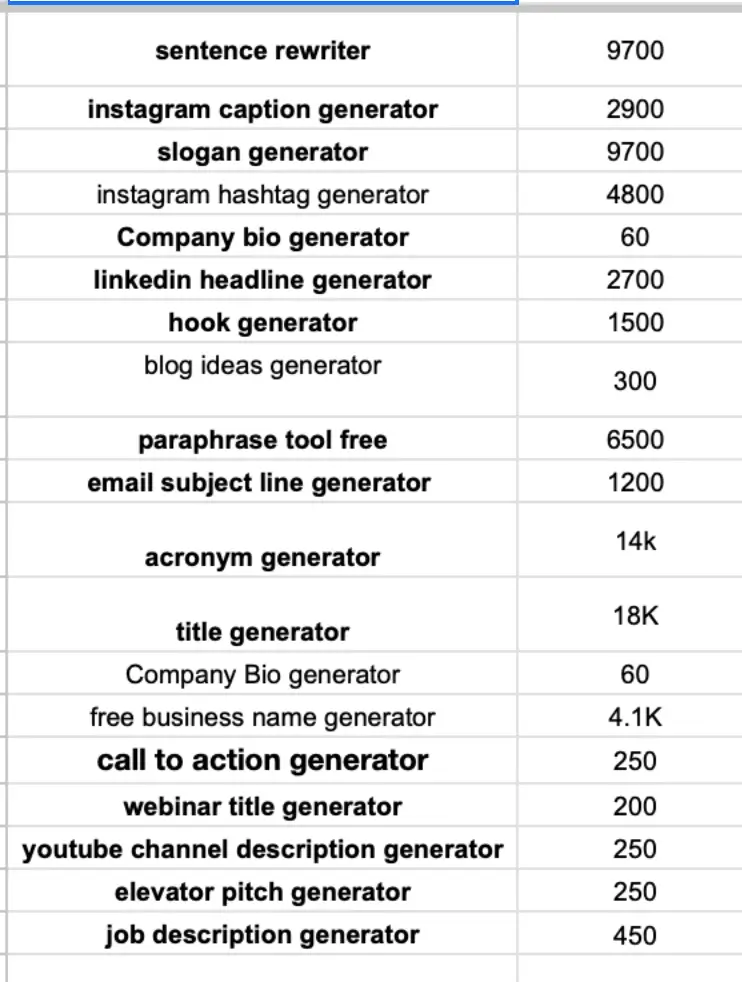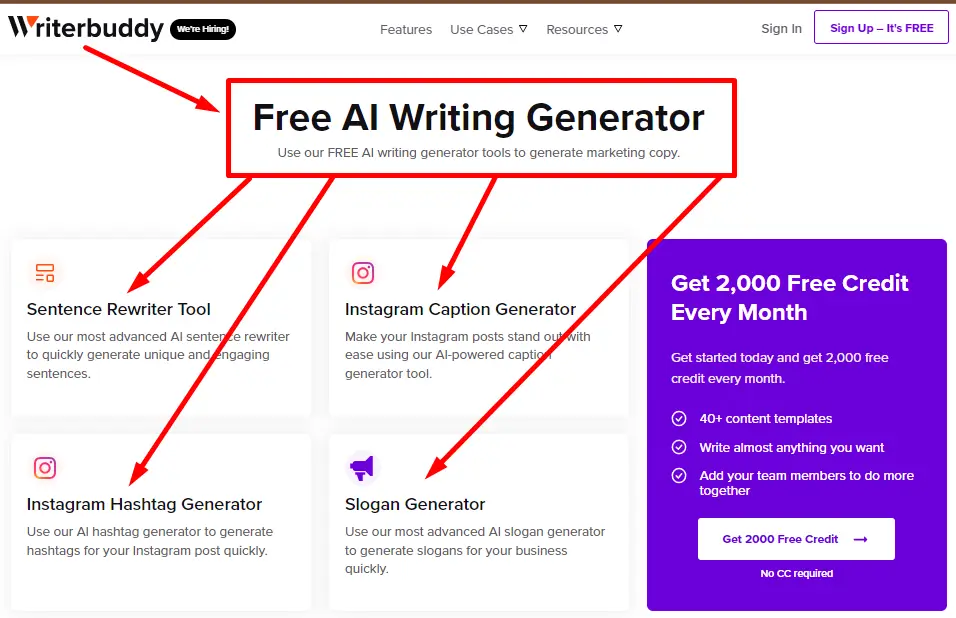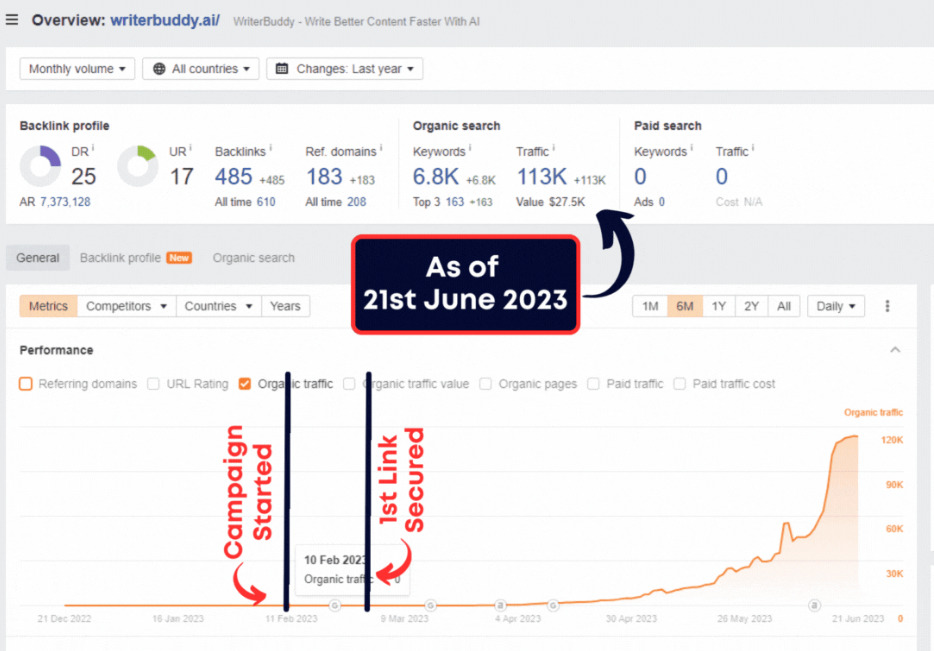Here is a case study that explores the ways to skyrocket your SaaS SEO traffic and customer acquisition.
Today, in this presentation, you’ll see how we helped our client WriterBuddy AI go from 0 to 100K/mo organic traffic… in just 3 months.
It also became their #1 acquisition channel while tripling MRR!
Yes, you read that right!
In this article, we’ll spill all the secrets, showing you exactly how we did it.
We managed to integrate product-led growth with SEO. Want to find out how? Keep reading…
Meet WriterBuddy AI
Client Objective
WriterBuddy AI had a brand-new website, and you know what? It’s no secret that SEO for new websites can be challenging, especially in the B2B space with established competitors. Even then, WriterBuddy AI had some clear goals:
- They wanted to rank for many fairly competitive keywords, e.g., acronym generator, paraphrasing tool, sentence rewriter, hook generator, instagram caption generator, etc.
- They needed the results ASAP to generate an ROI and use the profits to reinvest in their business.
Challenges: A Tough Start
WriterBuddy AI had a hard time ranking on Google. Why? Well, a few reasons:
- Targeting fairly competitive keywords while having ZERO authority in the eyes of Google as they had a newly registered domain.
- Competing with well-established players such as Copyai, Jasper, Writesonic, Rytr, etc.
- Trying to rank for money-making, transactional keywords that list online writing tools, not blog posts. So, there wasn’t any way to improve the “Content Quality” in this case.
- It was tricky connecting their product with SEO, making it hard to get people to find them.
Though not an easy task, our process enabled us to quickly tap into Writerbuddy’s strength to rank for buyer intent keywords (more on this later).
Writerbuddy AI X OneLittleWeb SEO Strategy
SEO Accelerator Overview
OneLittleWeb’s SEO Accelerator aims to provide a hassle-free, all-inclusive, and fully managed SEO content marketing experience for SaaS businesses. We take care of everything, tailoring our approach specifically for sites by building a niche-expert content team. This is done so that you can sustainably predict your revenue.
This works in the following aspects:
- Strategy
- Content
- Authority
We at OneLittleWeb, manage some of the biggest websites in various niches. To date, we’ve worked with over 1100 clients and generated 1B+ traffic for them. So, we know the 80/20 of SEO, and that allows us to understand what works and what does not.
Writerbuddy AI SEO Strategy
Audit & Growth Plan
As a new site, WriterBuddy didn’t have issues with the technical aspect of SEO. We only optimized their site speed and integrated Google Search Console and Google Analytics 4. The integration would allow us to look at:
- The source of clients’ traffic.
- The pages that were converting best.
- Ways to advise our clients on improving the user experience.
- Proven funnel steps to make SEO their #1 acquisition channel.
Competitor Analysis
To prepare a data-driven strategy, we dug up WriterBuddy’s competitors to find out their strongholds.
You know what, when we entered the scene, WriterBuddy was up against established players like ChatGPT, making their ambition of creating an AI writing tool seem almost impossible. On top of that, Copyai, Jasper, and many other key players were dominating the SERPs.
However, we firmly believe in the power of Google as the ultimate marketing tool. Even with our backs against the wall, this challenge fueled our creativity. Drawing inspiration from Canva’s success, we developed a unique SEO strategy, Product-led SEO, that weaved WriterBuddy AI’s narrative into the vast digital landscape.
Keyword Research
We wanted to create a successful content strategy for WriterBuddy AI. So, initially, we looked at their competitors (Jasper AI, Copy.AI, WriteSonic, and Rytr) and audited their keywords, looking for some so we could snatch.
This is what we did:
- Sorted the keywords based on difficulty and traffic potential.
- Looked for low-difficulty, high-traffic potential keywords.
- Analyzed the search intent to decide whether we should go for a tool or a content piece.
- Added the relevant information to our content plan.
Through this approach, we aimed to hijack the competition’s traffic. These are some of the keywords we targeted:

By ranking for these keywords, we could connect Writerbuddy AI with users who were in the business/marketing space seeking an AI writer.
Content Strategy
In our product-led SEO strategy, we didn’t have any conventional content marketing strategies that others would suggest. Instead, we planned to use our keyword research to make free tools out of each keyword as a source of content.
Our client decided to agree with us, and we collaborated with them to prepare 25+ free AI tools, i.e., sentence rewriters, hook generators, etc.
Quick overview:
- Planned and named tools according to the keywords we wanted WriterBuddy AI to rank for.
- Worked with the WriterBuddy AI team to develop these tools.
We planned a topic cluster on ‘free tools’ and added all other free tools we prepared under this topic.
i.e.: https://writerbuddy.ai/free-tools/sentence-rewriter-tool

Initial 25+ free writing tools pages were on our Priority List, as we worked closely with WriterBuddy’s developer team to seamlessly integrate our content calendar with their products.
WriterBuddy AI Content Creation
As we didn’t have enough chance to optimize these tools’ pages, we seized the gap and wrote 1200–1500 words of “step-by-step how-to” content for each tool, getting their tool pages all-in-all SEO optimized.
Our plan was to drive as much traffic as possible on these free tool pages and show the audience a CTA to sign up for premium services. From there, Writerbuddy AI could prompt them to sign up with a lead magnet, which in their case was free credits.

Most importantly, this could multiply the email list of Writerbuddy, which would make users sign in and use up their credits. So that, eventually, they feel enticed to pay for more.
Writerbuddy AI SEO Authority
Now here’s still a catch. Remember, Writerbuddy was a new site with Zero SEO authority?
Our efforts wouldn’t mean anything if they didn’t rank. Even though the tools pages were all SEO optimized, Google gives much value to E-E-A-T, and that’s where this site lacked any visible advantage.
So, we had to add up more SEO strategies alongside the initial product-led SEO.
These are:
- Content-led PR Backlinks
- Authority Backlinks
Content-Led PR Backlinks
We chose this strategy to boost WriterBuddy’s overall SEO authority and a strong E-E-A-T profile so they could dominate the targeted keywords.
In this strategy, we opt to develop content that’s sure to grab the attention of the world’s most reputable publications with sheer SEO influence. This is done to make them link back to our client’s site so that we can use these backlinks to boost our client’s authority.
- Ideation: For WriterBuddy AI, we decided to create content that’s relevant to the AI industry and guarantees to pique the interest of journalists. In this case, we decided to develop a report on AI Investment Index 2015-23.
- Content Development: The content was developed with the help of rigorous 3-weeks of work by our four-person team consisting of a PR executive, data analyst, content writer, and visualizer. After ideating in collaboration with WriterBuddy, our data analysts sourced authentic data and prepared a unique data-backed research. From here on, our content writer turned that boring data into an appealing report suitable for our client’s site. Finally, as a cherry on top, our visualizer designed attractive infographics to hold the reader’s attention.
Check out the report here: AI Investment Report – The next gold rush?
- PR Outreach: After publishing the report, our PR outreach team crafted tailored email pitches for relevant journalists who also happen to write about the AI industry. Our experts pitched the report we developed as a source for their news coverage.
Can you guess the results? 44+ journalists replied back with backlinks on their sites, including TechCrunch, PCmag, MSN, TheWeek, and 40+ other globally recognized outlets.
Authority Backlinks
We know Content-led PR backlinks can do wonders for a site’s overall domain. With links from such reputable sources, WriterBuuddy’s DR increased from 0 to 24 in just two weeks!
This surge alone in DR made WritterBuddy AI’s organic traffic go from 0-100k+/m in less than three months. This was enough for a new SaaS to step in during their initial fourth month.
But we also knew that while their overall site domain authority increased, the money-making tool pages could use some extra dose of authority to attain sustainable growth.
So, we didn’t dare to stop there. Instead, we started to build backlinks from more authoritative sources like HubSpot, Forbes, etc. to ensure their tool pages get an authority boost and rank for keywords that search for these tools.
But why backlinks again?
You can never get tired of link-building. When the site’s content and technical SEO are all in good shape, you’re only left with link authority as a scalable method for your SEO efforts.
That’s exactly what we chose to continue.
Impact of SEO on WriterBuddy
This WriterBuddy AI campaign was a huge business success.
As you can see, we started the campaign on February 10th when our client had 0 organic traffic. The first link was secured 14 days later, on 24th February.
And editorial backlinks from top media outlets started to rain. Within 10 days, the Domain Rating surged from zero to 24. (Now it’s 30+.)
Then it went boom!
And look at the Ahrefs stats!
As of June 21, 2023, the organic traffic was 113k+/m!

Wrapping Up
I understand what you’re thinking. You don’t buy content, nor backlinks, nor SEO. It’s the value you look for. And see what values we managed to provide WritterBuddy AI.
Within just three months, our overall SEO efforts took WriterBuddy AI from 0 to 100k+/m organic traffic. This means $1000 worth (According to Ahrefs) of PPC traffic, coming completely for FREE, organically, every single month.
This huge chunk of monthly organic traffic helped us to take WriterBuddy’s MRR from 0 to 5 figures in just six months, and currently, this is increasing more at an intriguing pace.
They are now converting 3% of their traffic into their free-credit (freemium) pack.
Also, the Free credit user to premium subscription conversion rate is close to 1%.
With this data, they can predict their revenue from the organic traffic they are receiving. The team at WriterBuddy is actually working on increasing the conversion rate while we are focused on providing them with more organic traffic with our SEO content marketing.
You know, if you invest in Facebook, Twitter, or other social media to advertise your product, you’ll have to pay them. But for Google, you don’t need to pay when you are invested in strategy, content, and authority!
Google is the best marketing tool on planet Earth. Because the ROI that Google traffic provides is insane.
Research says the conversion rate for traffic generated from SEO content marketing is 14.6%, compared to 1.7% for paid ads.
And it’s not only us. SaaS giants like Canva, Typeform, Zapier, Tinyseed, and even unicorns know it. They are crushing on SEO, using it as their #1 acquisition channel. That’s exactly what we are doing for WriterBuddy and our other SaaS clients.
If you want to add similar values to your SaaS using our SEO content marketing, let’s discuss this on a one-on-one call.
Book a call with me, and we’ll show you how we can provide value for your SaaS through SEO content marketing. So that you, too, can predict your revenue for the coming months!




